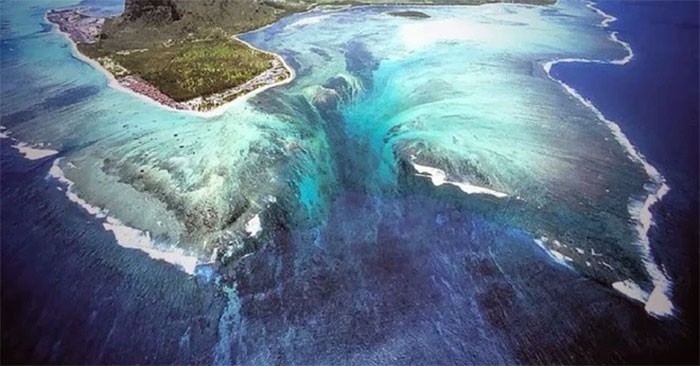Comment récupérer laccès au disque dur, corriger lerreur dimpossibilité douvrir le disque dur

Dans cet article, nous vous expliquerons comment récupérer l'accès à votre disque dur en cas de panne. Suivez-nous !
The title of the world's largest and tallest waterfall belongs to the Denmark Strait Falls, which is 3,500 meters high. This waterfall is a sheer drop in the strait between Greenland and Iceland, meaning it is underwater.
Temperature and salinity differences power most ocean currents, so the Denmark Strait waterfall has a flow rate of nearly 3.5 million cubic meters per second.
The Denmark Strait crosses the Arctic Circle and acts as a funnel for polar waters to flow from the Nordic seas into the Atlantic Ocean.
The waterfall is caused by the density difference between the waters of the Greenland Sea and the Irminger Sea. North of the Denmark Strait, the surface water is exposed to cold Arctic air and becomes colder as some of the water freezes. Salt then concentrates in the unfrozen area. The cold, salty water is denser than the warmer water, so it sinks to the bottom, while the lighter layer rises to the top. This causes a deep current to flow south through the strait, emptying into the Irminger Sea in the North Atlantic.
The Denmark Strait also has a cliff or ramp like other terrestrial waterfalls. It is a 3,500 m high ledge on the sea floor near the southern tip of Greenland that was created by glaciers 11,500 - 17,500 years ago, during the last Ice Age. Water from the sea floor flows through the strait, over the edge of the ledge and down its slopes, forming a waterfall beneath the warmer surface waters of the Irminger Sea.

Although the seabed slopes down more than 3,500 m, because it flows into a deep lake containing cold and dense water, the overflow is only about 2,000 m high. The overflow is as wide as the Denmark Strait, spread over 480 km of seabed, so the downward flow speed is only about 0.5 m/s, much slower than the flow speed at Niagara Falls (109 km/h), or 30.5 m/s.
The highest waterfall on land is Angel Falls with a height of 979 m and a width of 150 m at the base, equivalent to 3 Eiffel Towers stacked on top of each other.
Dans cet article, nous vous expliquerons comment récupérer l'accès à votre disque dur en cas de panne. Suivez-nous !
À première vue, les AirPods ressemblent à n'importe quel autre écouteur sans fil. Mais tout a changé avec la découverte de quelques fonctionnalités peu connues.
Apple a présenté iOS 26 – une mise à jour majeure avec un tout nouveau design en verre dépoli, des expériences plus intelligentes et des améliorations des applications familières.
Craving for snacks but afraid of gaining weight? Dont worry, lets explore together many types of weight loss snacks that are high in fiber, low in calories without making you try to starve yourself.
Rest and recovery are not the same thing. Do you really need rest days when you schedule a workout? Lets find out!
Les étudiants ont besoin d'un ordinateur portable spécifique pour leurs études. Il doit être non seulement suffisamment puissant pour être performant dans la filière choisie, mais aussi suffisamment compact et léger pour être transporté toute la journée.
L'ajout d'une imprimante à Windows 10 est simple, bien que le processus pour les appareils filaires soit différent de celui pour les appareils sans fil.
Comme vous le savez, la RAM est un composant matériel essentiel d'un ordinateur. Elle sert de mémoire pour le traitement des données et détermine la vitesse d'un ordinateur portable ou de bureau. Dans l'article ci-dessous, WebTech360 vous présente quelques méthodes pour détecter les erreurs de RAM à l'aide d'un logiciel sous Windows.
Refrigerators are familiar appliances in families. Refrigerators usually have 2 compartments, the cool compartment is spacious and has a light that automatically turns on every time the user opens it, while the freezer compartment is narrow and has no light.
Wi-Fi networks are affected by many factors beyond routers, bandwidth, and interference, but there are some smart ways to boost your network.
Si vous souhaitez revenir à la version stable d'iOS 16 sur votre téléphone, voici le guide de base pour désinstaller iOS 17 et rétrograder d'iOS 17 à 16.
Le yaourt est un aliment merveilleux. Est-il bon de manger du yaourt tous les jours ? Si vous mangez du yaourt tous les jours, comment votre corps va-t-il changer ? Découvrons-le ensemble !
Cet article présente les types de riz les plus nutritifs et comment maximiser les bienfaits pour la santé du riz que vous choisissez.
Établir un horaire de sommeil et une routine de coucher, changer votre réveil et ajuster votre alimentation sont quelques-unes des mesures qui peuvent vous aider à mieux dormir et à vous réveiller à l’heure le matin.
Get Bathroom Tower Defense Roblox game codes and redeem them for exciting rewards. They will help you upgrade or unlock towers with higher damage.













